Abstract
Oxidation of LDL by peroxidases has been suggested to be a model for in vivo oxidation. The mechanism might involve the generation of an intermediate radical such as a phenoxy radical. We show that, in contrast to the oxidation of LDL by copper, oxidation by peroxidase system (H2O2/horse radish peroxidase) showed less resistance. This suggested that either the antioxidants were consumed more rapidly or might have actually participated in the oxidation. Accordingly, addition of vitamin E increased the rate of oxidation of LDL. In contrast, probucol inhibited the oxidation even at low concentrations suggesting ineffective formation of probucol radical or the sterically hindered probucol radical was inefficient in catalyzing subsequent oxidation. The oxidation of LDL by horse radish peroxidase was also enhanced in the presence of diphenylphenylenediamine, an antioxidant that does not have a phenolic -OH group. Myeloperoxidase was able to oxidize LDL even in the absence of added tyrosine suggesting that it was able to utilize the LDL-associated vitamin E. Addition of free tyrosine inhibited the formation of conjugated dienes. We suggest that if peroxidases are involved in the initiation of LDL oxidation in vivo, higher concentrations of antioxidants may be indicated to inhibit propagation of oxidation.
Full text
PDF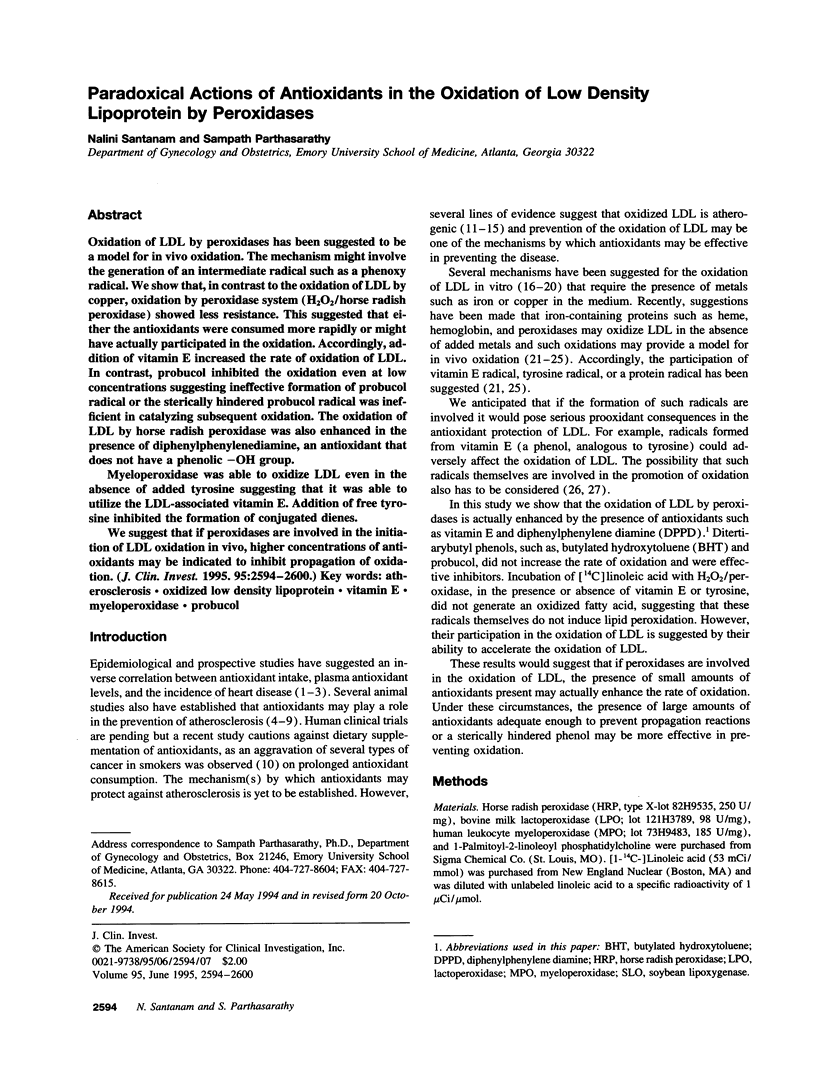
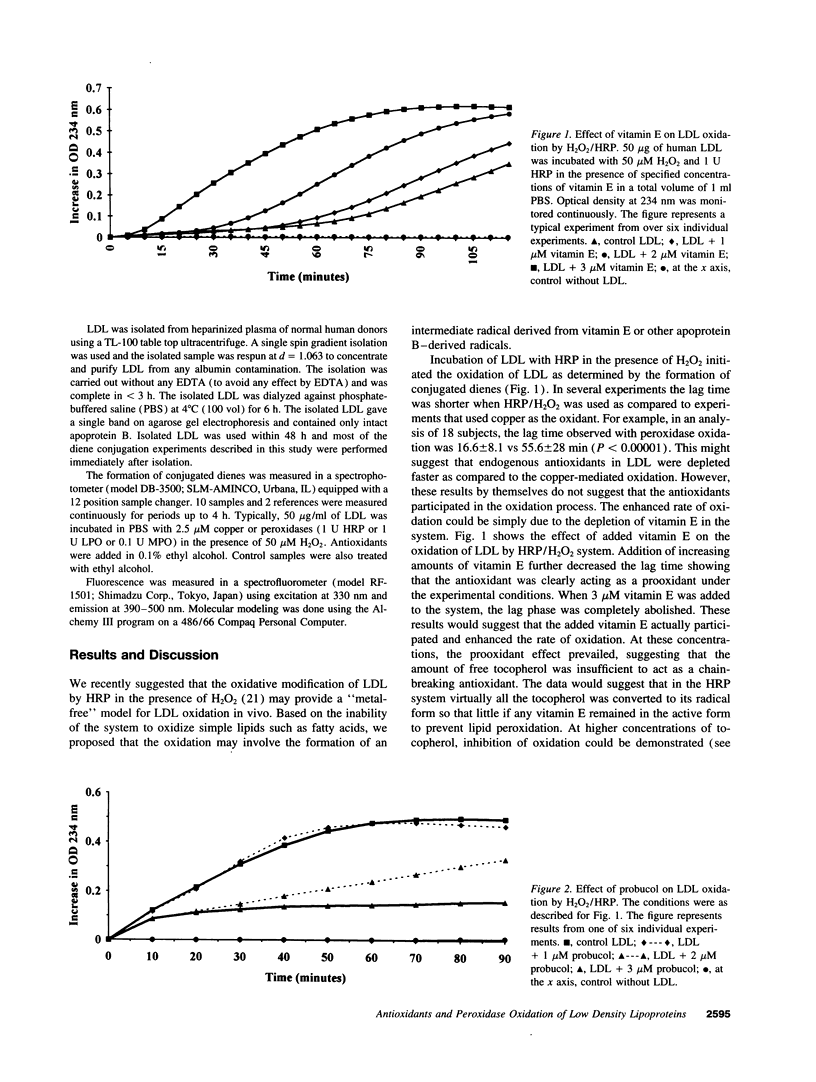
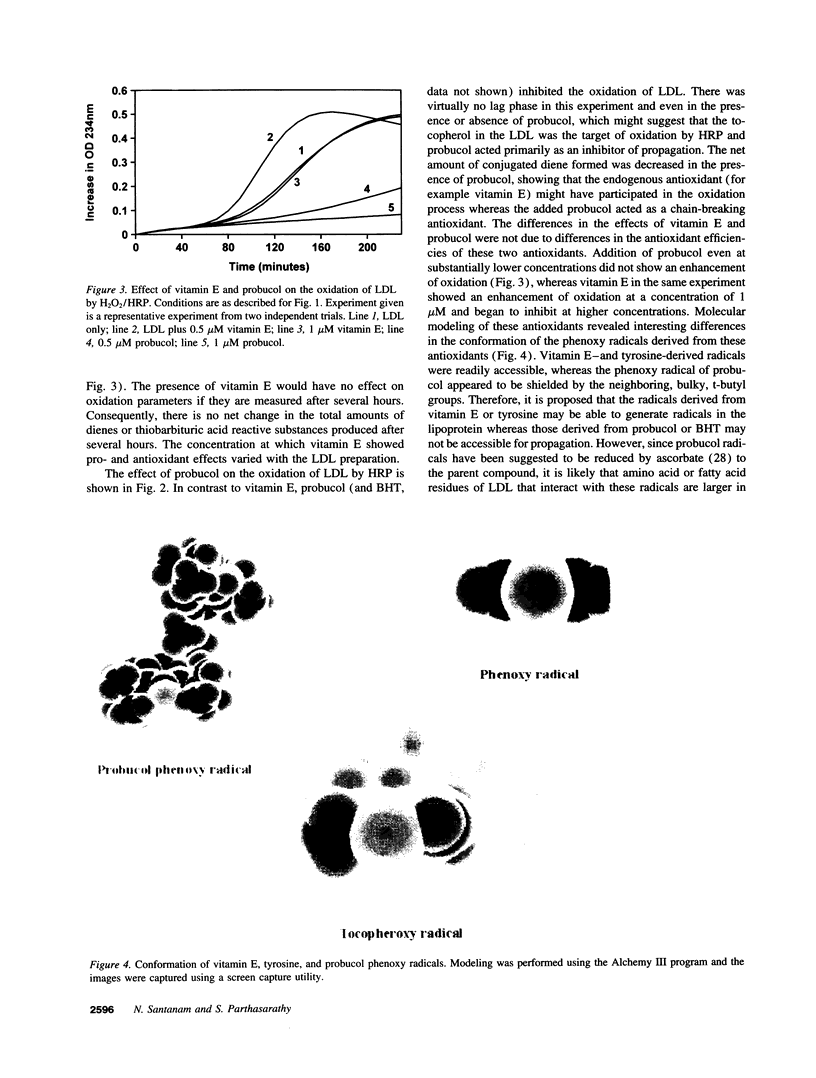
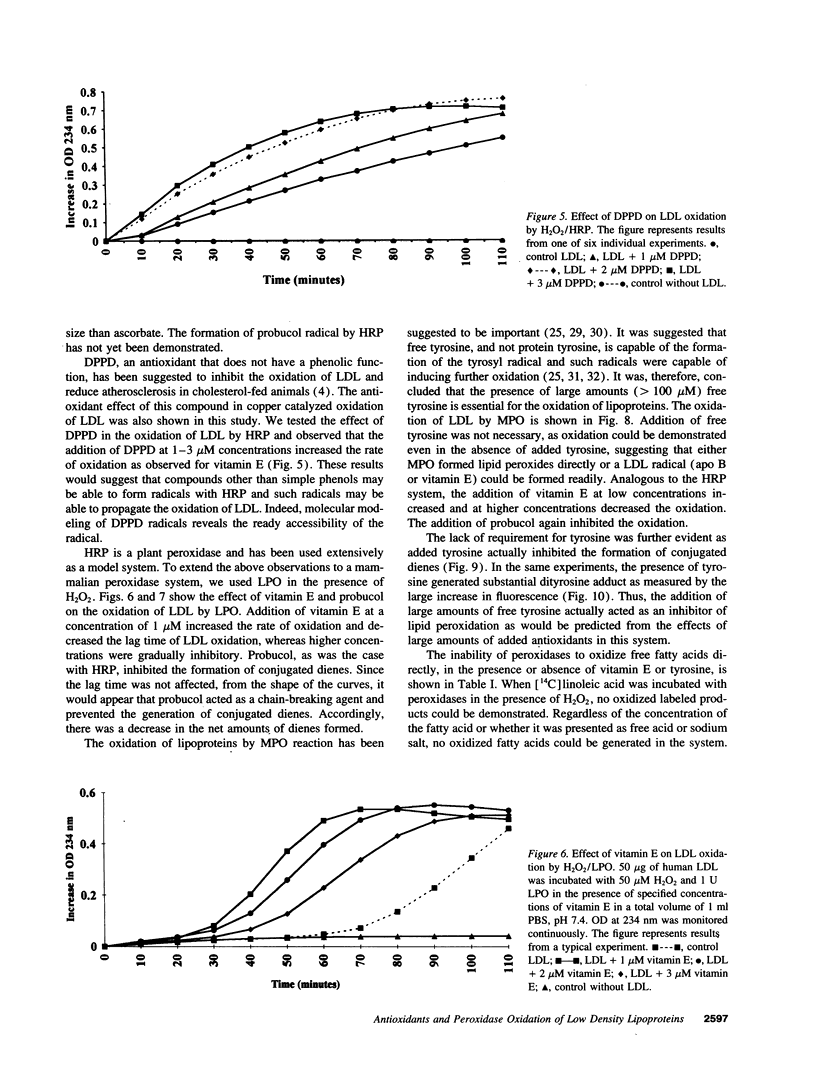
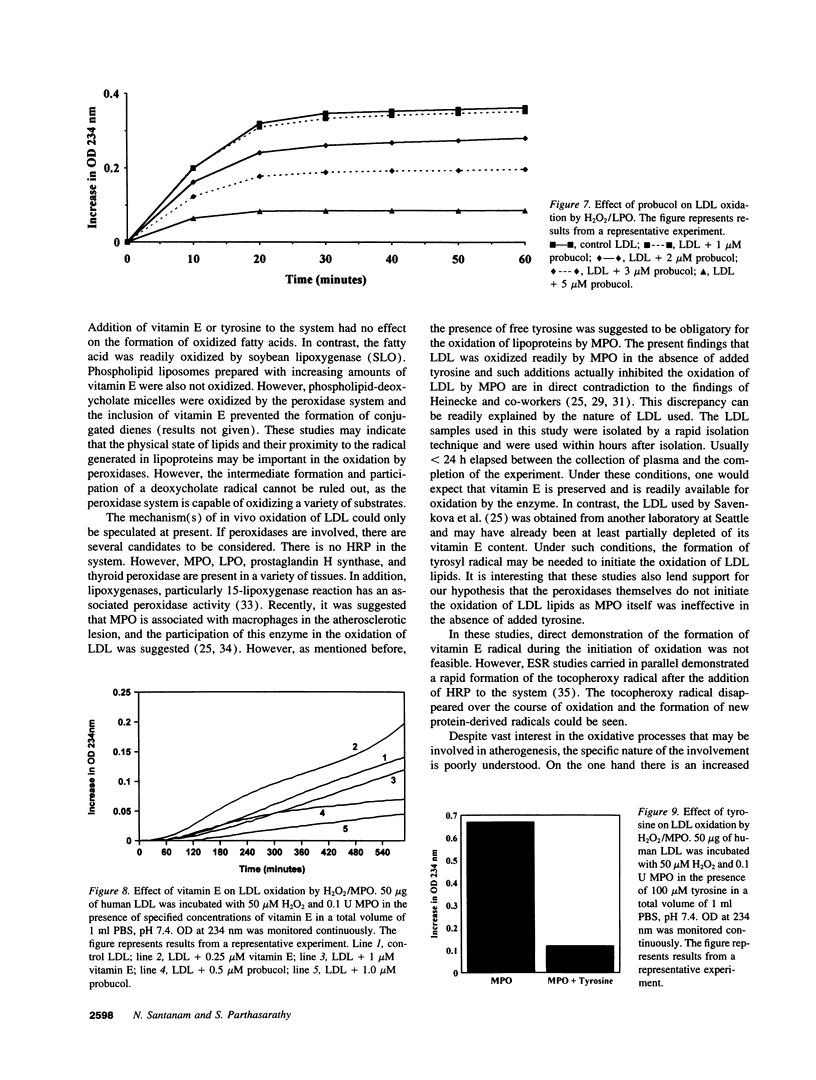
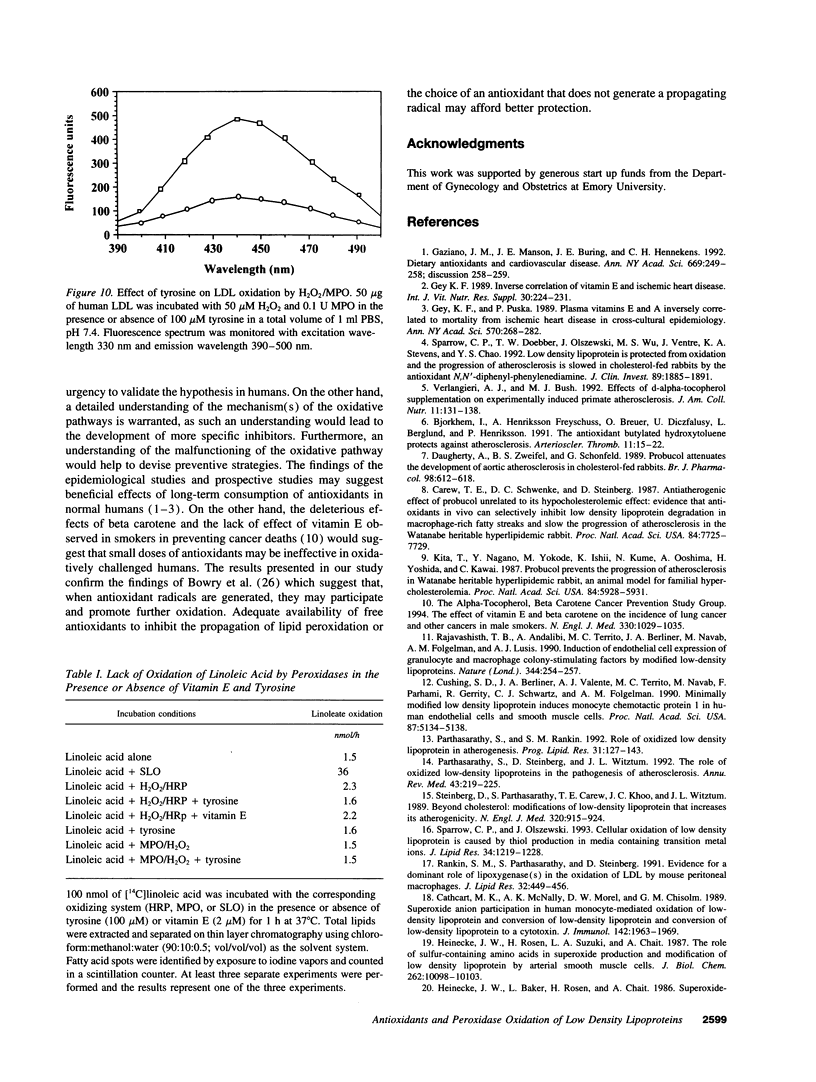

Images in this article
Selected References
These references are in PubMed. This may not be the complete list of references from this article.
- Balla G., Jacob H. S., Eaton J. W., Belcher J. D., Vercellotti G. M. Hemin: a possible physiological mediator of low density lipoprotein oxidation and endothelial injury. Arterioscler Thromb. 1991 Nov-Dec;11(6):1700–1711. doi: 10.1161/01.atv.11.6.1700. [DOI] [PubMed] [Google Scholar]
- Björkhem I., Henriksson-Freyschuss A., Breuer O., Diczfalusy U., Berglund L., Henriksson P. The antioxidant butylated hydroxytoluene protects against atherosclerosis. Arterioscler Thromb. 1991 Jan-Feb;11(1):15–22. doi: 10.1161/01.atv.11.1.15. [DOI] [PubMed] [Google Scholar]
- Bowry V. W., Ingold K. U., Stocker R. Vitamin E in human low-density lipoprotein. When and how this antioxidant becomes a pro-oxidant. Biochem J. 1992 Dec 1;288(Pt 2):341–344. doi: 10.1042/bj2880341. [DOI] [PMC free article] [PubMed] [Google Scholar]
- Carew T. E., Schwenke D. C., Steinberg D. Antiatherogenic effect of probucol unrelated to its hypocholesterolemic effect: evidence that antioxidants in vivo can selectively inhibit low density lipoprotein degradation in macrophage-rich fatty streaks and slow the progression of atherosclerosis in the Watanabe heritable hyperlipidemic rabbit. Proc Natl Acad Sci U S A. 1987 Nov;84(21):7725–7729. doi: 10.1073/pnas.84.21.7725. [DOI] [PMC free article] [PubMed] [Google Scholar]
- Cathcart M. K., McNally A. K., Morel D. W., Chisolm G. M., 3rd Superoxide anion participation in human monocyte-mediated oxidation of low-density lipoprotein and conversion of low-density lipoprotein to a cytotoxin. J Immunol. 1989 Mar 15;142(6):1963–1969. [PubMed] [Google Scholar]
- Cucurou C., Battioni J. P., Daniel R., Mansuy D. Peroxidase-like activity of lipoxygenases: different substrate specificity of potato 5-lipoxygenase and soybean 15-lipoxygenase and particular affinity of vitamin E derivatives for the 5-lipoxygenase. Biochim Biophys Acta. 1991 Jan 4;1081(1):99–105. doi: 10.1016/0005-2760(91)90256-h. [DOI] [PubMed] [Google Scholar]
- Cushing S. D., Berliner J. A., Valente A. J., Territo M. C., Navab M., Parhami F., Gerrity R., Schwartz C. J., Fogelman A. M. Minimally modified low density lipoprotein induces monocyte chemotactic protein 1 in human endothelial cells and smooth muscle cells. Proc Natl Acad Sci U S A. 1990 Jul;87(13):5134–5138. doi: 10.1073/pnas.87.13.5134. [DOI] [PMC free article] [PubMed] [Google Scholar]
- Daugherty A., Dunn J. L., Rateri D. L., Heinecke J. W. Myeloperoxidase, a catalyst for lipoprotein oxidation, is expressed in human atherosclerotic lesions. J Clin Invest. 1994 Jul;94(1):437–444. doi: 10.1172/JCI117342. [DOI] [PMC free article] [PubMed] [Google Scholar]
- Daugherty A., Zweifel B. S., Schonfeld G. Probucol attenuates the development of aortic atherosclerosis in cholesterol-fed rabbits. Br J Pharmacol. 1989 Oct;98(2):612–618. doi: 10.1111/j.1476-5381.1989.tb12635.x. [DOI] [PMC free article] [PubMed] [Google Scholar]
- Francis G. A., Mendez A. J., Bierman E. L., Heinecke J. W. Oxidative tyrosylation of high density lipoprotein by peroxidase enhances cholesterol removal from cultured fibroblasts and macrophage foam cells. Proc Natl Acad Sci U S A. 1993 Jul 15;90(14):6631–6635. doi: 10.1073/pnas.90.14.6631. [DOI] [PMC free article] [PubMed] [Google Scholar]
- Gaziano J. M., Manson J. E., Buring J. E., Hennekens C. H. Dietary antioxidants and cardiovascular disease. Ann N Y Acad Sci. 1992 Sep 30;669:249–259. doi: 10.1111/j.1749-6632.1992.tb17104.x. [DOI] [PubMed] [Google Scholar]
- Gey K. F. Inverse correlation of vitamin E and ischemic heart disease. Int J Vitam Nutr Res Suppl. 1989;30:224–231. [PubMed] [Google Scholar]
- Gey K. F., Puska P. Plasma vitamins E and A inversely correlated to mortality from ischemic heart disease in cross-cultural epidemiology. Ann N Y Acad Sci. 1989;570:268–282. doi: 10.1111/j.1749-6632.1989.tb14926.x. [DOI] [PubMed] [Google Scholar]
- Hazell L. J., Stocker R. Oxidation of low-density lipoprotein with hypochlorite causes transformation of the lipoprotein into a high-uptake form for macrophages. Biochem J. 1993 Feb 15;290(Pt 1):165–172. doi: 10.1042/bj2900165. [DOI] [PMC free article] [PubMed] [Google Scholar]
- Heinecke J. W., Baker L., Rosen H., Chait A. Superoxide-mediated modification of low density lipoprotein by arterial smooth muscle cells. J Clin Invest. 1986 Mar;77(3):757–761. doi: 10.1172/JCI112371. [DOI] [PMC free article] [PubMed] [Google Scholar]
- Heinecke J. W., Li W., Daehnke H. L., 3rd, Goldstein J. A. Dityrosine, a specific marker of oxidation, is synthesized by the myeloperoxidase-hydrogen peroxide system of human neutrophils and macrophages. J Biol Chem. 1993 Feb 25;268(6):4069–4077. [PubMed] [Google Scholar]
- Heinecke J. W., Li W., Francis G. A., Goldstein J. A. Tyrosyl radical generated by myeloperoxidase catalyzes the oxidative cross-linking of proteins. J Clin Invest. 1993 Jun;91(6):2866–2872. doi: 10.1172/JCI116531. [DOI] [PMC free article] [PubMed] [Google Scholar]
- Heinecke J. W., Rosen H., Suzuki L. A., Chait A. The role of sulfur-containing amino acids in superoxide production and modification of low density lipoprotein by arterial smooth muscle cells. J Biol Chem. 1987 Jul 25;262(21):10098–10103. [PubMed] [Google Scholar]
- Kalyanaraman B., Darley-Usmar V. M., Wood J., Joseph J., Parthasarathy S. Synergistic interaction between the probucol phenoxyl radical and ascorbic acid in inhibiting the oxidation of low density lipoprotein. J Biol Chem. 1992 Apr 5;267(10):6789–6795. [PubMed] [Google Scholar]
- Kita T., Nagano Y., Yokode M., Ishii K., Kume N., Ooshima A., Yoshida H., Kawai C. Probucol prevents the progression of atherosclerosis in Watanabe heritable hyperlipidemic rabbit, an animal model for familial hypercholesterolemia. Proc Natl Acad Sci U S A. 1987 Aug;84(16):5928–5931. doi: 10.1073/pnas.84.16.5928. [DOI] [PMC free article] [PubMed] [Google Scholar]
- Paganga G., Rice-Evans C., Andrews B., Leake D. Oxidised low density lipoproteins convert oxyhaemoglobin from ruptured erythrocytes to reactive ferryl forms. Biochem Soc Trans. 1992 Nov;20(4):331S–331S. doi: 10.1042/bst020331s. [DOI] [PubMed] [Google Scholar]
- Panasenko O. M., Evgina S. A., Aidyraliev R. K., Sergienko V. I., Vladimirov Y. A. Peroxidation of human blood lipoproteins induced by exogenous hypochlorite or hypochlorite generated in the system of "myeloperoxidase + H2O2 + Cl-". Free Radic Biol Med. 1994 Feb;16(2):143–148. doi: 10.1016/0891-5849(94)90137-6. [DOI] [PubMed] [Google Scholar]
- Parthasarathy S., Rankin S. M. Role of oxidized low density lipoprotein in atherogenesis. Prog Lipid Res. 1992;31(2):127–143. doi: 10.1016/0163-7827(92)90006-5. [DOI] [PubMed] [Google Scholar]
- Parthasarathy S., Steinberg D., Witztum J. L. The role of oxidized low-density lipoproteins in the pathogenesis of atherosclerosis. Annu Rev Med. 1992;43:219–225. doi: 10.1146/annurev.me.43.020192.001251. [DOI] [PubMed] [Google Scholar]
- Rajavashisth T. B., Andalibi A., Territo M. C., Berliner J. A., Navab M., Fogelman A. M., Lusis A. J. Induction of endothelial cell expression of granulocyte and macrophage colony-stimulating factors by modified low-density lipoproteins. Nature. 1990 Mar 15;344(6263):254–257. doi: 10.1038/344254a0. [DOI] [PubMed] [Google Scholar]
- Rankin S. M., Parthasarathy S., Steinberg D. Evidence for a dominant role of lipoxygenase(s) in the oxidation of LDL by mouse peritoneal macrophages. J Lipid Res. 1991 Mar;32(3):449–456. [PubMed] [Google Scholar]
- Savenkova M. L., Mueller D. M., Heinecke J. W. Tyrosyl radical generated by myeloperoxidase is a physiological catalyst for the initiation of lipid peroxidation in low density lipoprotein. J Biol Chem. 1994 Aug 12;269(32):20394–20400. [PubMed] [Google Scholar]
- Sparrow C. P., Doebber T. W., Olszewski J., Wu M. S., Ventre J., Stevens K. A., Chao Y. S. Low density lipoprotein is protected from oxidation and the progression of atherosclerosis is slowed in cholesterol-fed rabbits by the antioxidant N,N'-diphenyl-phenylenediamine. J Clin Invest. 1992 Jun;89(6):1885–1891. doi: 10.1172/JCI115793. [DOI] [PMC free article] [PubMed] [Google Scholar]
- Sparrow C. P., Olszewski J. Cellular oxidation of low density lipoprotein is caused by thiol production in media containing transition metal ions. J Lipid Res. 1993 Jul;34(7):1219–1228. [PubMed] [Google Scholar]
- Steinberg D., Parthasarathy S., Carew T. E., Khoo J. C., Witztum J. L. Beyond cholesterol. Modifications of low-density lipoprotein that increase its atherogenicity. N Engl J Med. 1989 Apr 6;320(14):915–924. doi: 10.1056/NEJM198904063201407. [DOI] [PubMed] [Google Scholar]
- Verlangieri A. J., Bush M. J. Effects of d-alpha-tocopherol supplementation on experimentally induced primate atherosclerosis. J Am Coll Nutr. 1992 Apr;11(2):131–138. [PubMed] [Google Scholar]
- Wieland E., Parthasarathy S., Steinberg D. Peroxidase-dependent metal-independent oxidation of low density lipoprotein in vitro: a model for in vivo oxidation? Proc Natl Acad Sci U S A. 1993 Jul 1;90(13):5929–5933. doi: 10.1073/pnas.90.13.5929. [DOI] [PMC free article] [PubMed] [Google Scholar]
- Yamamoto K., Niki E. Interaction of alpha-tocopherol with iron: antioxidant and prooxidant effects of alpha-tocopherol in the oxidation of lipids in aqueous dispersions in the presence of iron. Biochim Biophys Acta. 1988 Jan 19;958(1):19–23. doi: 10.1016/0005-2760(88)90241-x. [DOI] [PubMed] [Google Scholar]



